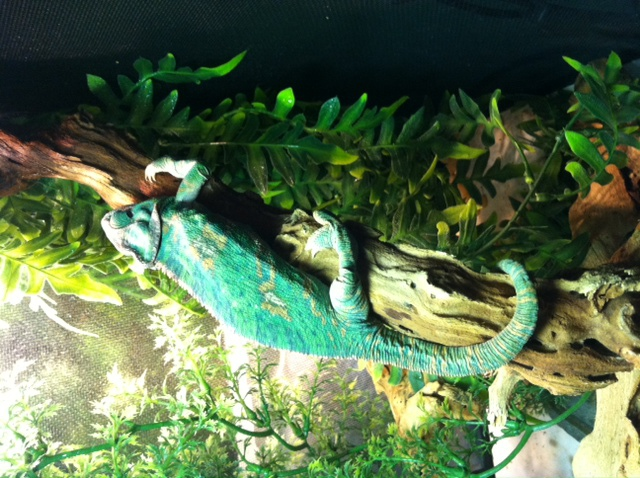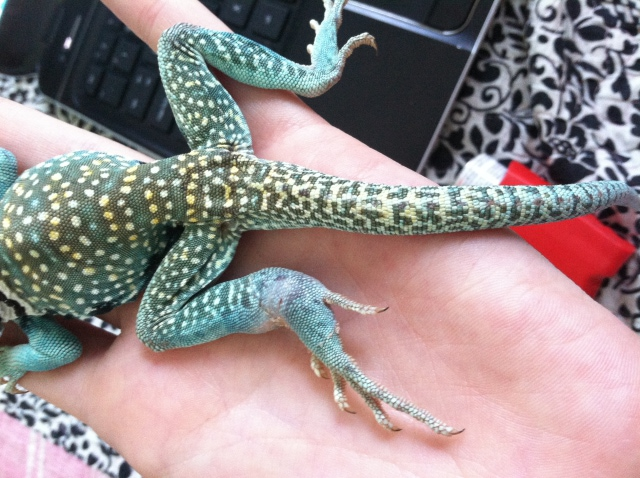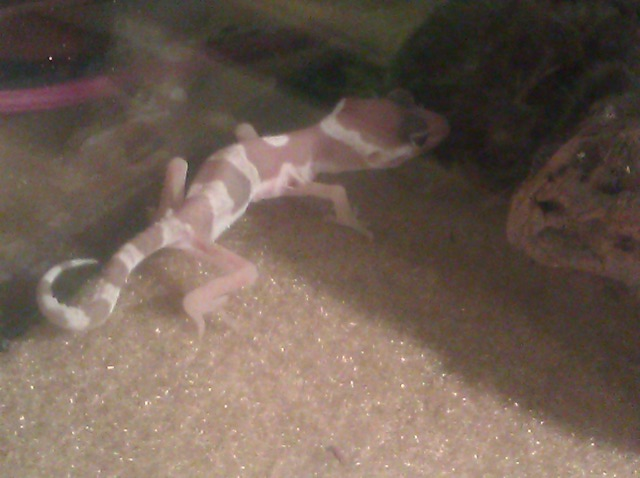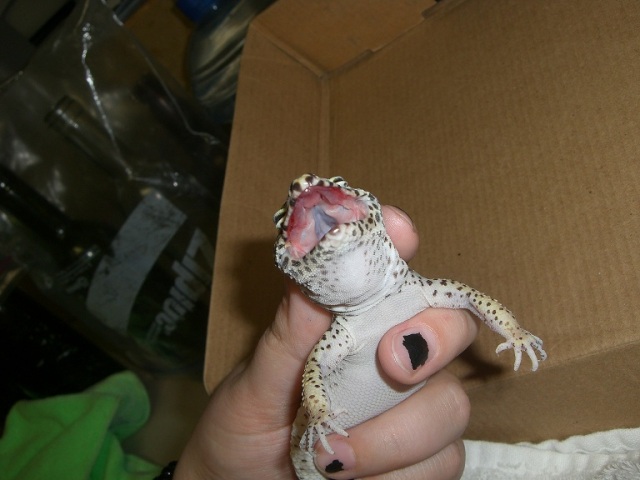QuestionQUESTION: Hi I have a 6 year old leopard gecko gecko that is having trouble shedding. She has problems getting skin of her face and has lost many fingers in her life and now she has problems getting it of her tail tip and underside, I did not realize they needed moisture up till this point. She has an undertank heater with a calcium sand bending and a cave hide. How do I keep it moist enough so that she will shed properly from here on out?
ANSWER: Hi Liam,
It is recommended to use what is called a "humid hide" for your leo. Basically, it is like a humidity chamber for them. I'm including a basic care sheet that I wrote to help people out caring for their leos. In it are simple ways to make a humid hide for your leo. Temperatures and sizes are NOT in Metric or Celsius.
Also, I want to point out that calci sand is deadly to leos. They accidentally eat it and it causes blockages...It does NOT digest as they claim!!! Again, more on this in the care sheet.
For the areas that have retained shed now, if after you give her a humid hide, she does not shed, then you can try a few things such as a very shallow bath in warm water. If that still doesn't work, then you can apply Vaseline to the stuck shed areas. I don't recommend using it around the mouth or nostrils though.
Once you get the proper tumid hide and also get thick layers of shed removed, she should be fine. With the humid hide you may find that you never see her with loose skin again!!!
I do want to mention that you don't want to try pulling off stuck shed as it will damage their skin.
BASIC CARE FOR A LEOPARD GECKO
Leopards are pretty easy to care for but they do need
special care. Here are some of the basic needs of your gecko.
HOUSING: The need to have at least a 20 gallon long tank for one Leo. This needs to have a secure fitting screen top...they can be quite the escape artists!!! They need to have a humid hide box.You can make this with something as simple as a small plastic dish with a hole cut in one side and a small mesh bag filled with some Sphagnum moss coconut bark or Peat moss that you mist.
I made mine out of the small plastic Folgers coffee containers...I cut an opening in the lid..and put the moss in..they LOVE it. I use the terrarium moss in mine.
I use that on the warm side of the tank. Be sure to provide a cool hide box on the other end. I also provide a mid temperature hide...which is in the middle of the tank.I use the critter caves which you can purchase. NOT the ones that have heat in them!!!!
Provide secure climbing areas for your gecko. Fake plants, rocks and branches are all fine to use. be sure there are no wires or sharp ends to any fake plants you use.
*****SUBSTRATE:(that's the stuff on the floor of your tank) Newspaper, lizard carpet or paper towels work great and are easy to clean and are much safer than any loose substrate. Sand or other loose substrate is not recommended as that they can be deadly to the leo when it is ingested(eaten, even by accident while eating their insects)...A very graphic site of an impacted leo surg can be seen at http://homepage.mac.com/exoticdvm/reptile/PhotoAlbum181.html it is very graphic!!! ******What I have found that works great for safety and heat distribution is using about 1/4 inch of children's play sand(since the tiles fit tight together, there is no sand danger) on the bottom of the tank and on top that you place ceramic or slate floor tile. What is nice is that the 12 x 12 squares fit perfect in a 20 gallon tank with no spaces between the tiles. The sand and the tile distribute the heat wonderfully. Using the under tank heater as described is what distributes the heat. Also, overhead heat will help in heating the tiles...I've been using this set up for several years and the leos love it. Using a tile that isn't smooth is recommended. **********
TEMPERATURES: They need a warm area ( on the floor) of 88-92 degrees and a
cooler area in the upper 70s, low 80s. At night their temperature can drop to the low to mid 70's.
Never use a hot rock for a leopard gecko...or any reptile.
They can severely burn any reptile. You can use a heating
pad under the tank,under tank heater for the warm area. You can use a regular household light bulb in a dome fixture with a ceramic socket in it to keep the warm area at the 88-92 degree area if needed there, otherwise, placing the light bulb about midway in the tank will give the needed temperatures throughout the tank. You may have to play with the wattage of the bulb but generally 40-60 watts is sufficient.At night, no white light. If room temperatures stay above 70 degrees, no extra night heat is needed. The under tank heater or heating pad should cover about 1/3 of the tank....be sure to raise the tank up about 1/4-1/2 inch off the stand when using an under tank heat source to prevent heat build up which can cause the glass to break and hot spots in the glass. Be sure to have a good layer of newspaper, carpeting or, even a thin flat rock(such as tile) on top the area that the under tank heat source is placed...if you use a thin rock or tile, it helps to distribute the heat very well.
You can use the special nighttime lights that are designed for reptiles. I like using a ceramic heat emitter on a thermostat for nighttime heat.
DO NOT use black lights or party lights as they can cause eye damage!!!!
The wattage you use will vary based on room temperature and size of tank.
LIGHTING: Leopard geckos do not need UVB lighting but it does not hurt them to give them uvb. They should have some type of light during the day, be it a uvb tube, regular florescent light, reptile day light or regular household light bulb. NO white lights at night!!!
FEEDING: Geckos should not be fed crickets or other insects that are bigger than the space between their eyes. Generally, hatchlings can be fed more than once a day,juvys can be fed twice a day, adults are fed once daily or every other day, in the early evening. Crickets and other food items such as silk worms, super, and an occasional treat of a wax worm, need to be dusted with a calcium supplement two times a week and also they should have a small dish of calcium in their tank. I use the lid of a milk jug for the little dish of calcium in their tank. For dusting the insects, Use a calcium with no added phosphorus. Insects must be gut loaded(fed) for at least 48 hours prior to feeding your gecko. Remove any uneaten crix or superworms after 15-20 minutes..... Place a piece of cut potato in the tank so that if you have missed any uneaten insects, they will eat the potato instead of nibbling on your gecko!!!
*************You have to be sure to feed your crickets and insects the right foods before feeding them to your gecko. If your crickets/insects are not healthy and well fed, your gecko will not get the nutrition he needs. You can gut load your crickets and insects greens, veggies, cereals or specially designed commercial foods for crickets or the insects you are feeding. ************
Be sure to have a small dish of clean water for your gecko at all times!!
You can offer them some baby food or fruits on occasion ...
Mine will even eat a small piece of watermelon now and then.WATER: always provide a dish of drinking water. If you choose to mist your gecko to drink, its best to not get the tank too wet as that they do not do well with higher humidity. Sometimes its better to take your leo out of their tank to mist them to get them to drink!!!
HANDLING: Some geckos enjoy being held...others prefer not to be handled at all. Be sure to be very gentle when holding your leo and NEVER grab them by the tail! Their tails are extremely fragile and will break.
I do suggest finding a vet that can treat reptiles BEFORE you actually need one!!! To find a vet that is able to care for reptiles:
http://www.herpvetconnection.com
http://www.arav.org/ECOMARAV/timssnet/amm/tnt_mdsearch.cfm
http://www.anapsid.org/vets/
For more information on leopard geckos:
http://www.drgecko.com
If you have any questions or don't understand something, please let me know.
---------- FOLLOW-UP ----------
QUESTION: The part that my lizard can't shed right now is on the top part of her lip around her nose and a small part on the tip if her eye lid and on her underside, and she's been in the calcium sand since I got her as a baby so I never even thought about it. I'm wondering I should replace my undertank heater because its am temp right now is roughly 24-27 degree Celsius. So should it be replaced considering its 6 years old and should I lay down paper towel as a bedding since I've seen so many people do that? As well as how often should I spray the new peat miss or the bedding you suggested for the hide?
ANSWER: Hi Liam,
You want to spray teh humid hide moss as often as it is needed to keep it moist. That might be daily or every other day. You just have to monitor it.
Those temperatures are low..but.. is that the temperature of the air or the floor over the undertank heater? If it is the air, you need to check the temperature on the floor where the Under tank heater is. I always recommend an overhead heat source on the warm side also so that the entire part of the tank (about 1/3 of the tank) is at the recommended "basking" temperatures.
Paper towels work fine for the flooring...personally, I like the tiles because they do distribute the heat so much better.
Hopefully the humid hide will help get those stuck shed areas cleaned off. On her underside, as I said, you can try the humid hide, a bath or the Vaseline.
---------- FOLLOW-UP ----------
QUESTION: The temperature thermometer is attached to the heater so I would assume that is the floor temperature
AnswerIf that is the floor temperature in the basking area, it is too chilly. You might want to add overhead heat . For daytime, a regular light bulb will work..you will have to play with the wattage to find what works best. If you prefer, you can use a ceramic heat emitter or a nocturnal bulb that would be fine for both day and night.
Double check your under tank heater to make sure it is still attached properly to the bottom of the tank. Sometimes they tend to come loose.

 1 year old female veiled chameleon
QuestionLizzy
Lizzys Setup
QUESTION: I ha
1 year old female veiled chameleon
QuestionLizzy
Lizzys Setup
QUESTION: I ha
 collared lizard swollen leg
QuestionQUESTION: Hi, I have a common collared lizard t
collared lizard swollen leg
QuestionQUESTION: Hi, I have a common collared lizard t
 Gravid Leopard Gecko?
QuestionBelly
QUESTION: Hello,
Im pretty new to
Gravid Leopard Gecko?
QuestionBelly
QUESTION: Hello,
Im pretty new to
 Leopard Gecko SICK
Question
Leo Gecko Under His Tail
I just r
Leopard Gecko SICK
Question
Leo Gecko Under His Tail
I just r
 Mouth Rot
Question
Scratchs mouth
Hi there, I sent a question you
Mouth Rot
Question
Scratchs mouth
Hi there, I sent a question you